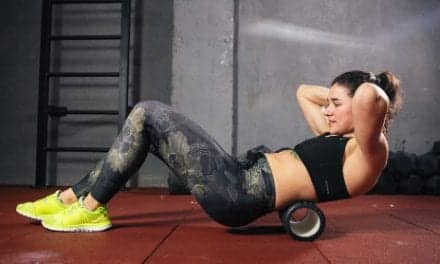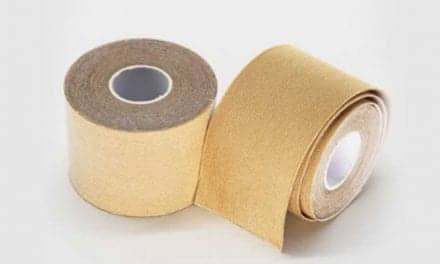
Wil Siegel, PT, DPT, MBA, Cert MDT, site supervisor at Burke’s Mamaroneck, NY, outpatient clinic, works with a patient using the cold laser (LLTT) for lower extremity pain management.
By William M. Siegel, PT, DPT, MBA, Cert MDT
When participating in any strenuous physical activity, the muscles in the body become stressed. It is not uncommon to experienceå some type of muscle soreness, especially when beginning a new activity or ramping up an existing exercise program. A natural consequence of any physical activity is mild soreness. It is quite normal to experience discomfort 1 or 2 days after working out. This condition is known as delayed onset muscle soreness (DOMS) and can occur 24 to 48 hours after an activity.
DOMS can arise when muscles are required to work harder or when they are used in a different way than they are used to functioning. It is believed that this type of soreness is caused by microscopic damage to the muscle fibers resulting in soreness or stiffness. Ironically, this muscle adaptation phase can actually lead to greater stamina and strength as the muscles recover and develop. DOMS will usually pass in 3 to 5 days and does not generally require medical intervention.
Older adults who may be attempting to commence a fitness program or increase daily activity levels may find themselves affected by DOMS. For older adults as well as the general population it is important not to confuse this pain with different types of pain that might be experienced during exercise or other functional activities. For example, acute, sudden, or sharp pain can be caused by a muscle strain or sprain. Chronic pain in the back or neck may be due to degenerative changes in the spine. Sharp or achy pain in the hips or knees may be due to osteoarthritis. This is particularly relevant since statistics from the Centers for Disease Control and Prevention indicate that osteoarthritis affects slightly more than one-third of adults age 65 years and older.
If a therapist’s client reports that pain makes it difficult to exercise, it is advisable for that client to refrain from activity for a few days or until the pain subsides. If the pain does not improve, it is then prudent to contact a physician who can perform a thorough assessment to better determine the cause of the complaints. In most cases, pain will arise from overuse or from degenerative changes to the spine or other joints. This process may worsen with age.
[sidebar float=”right” width=”250″]Product Resources
The following companies provide products for pain management:
ActiveWrap
www.activewrap.com
Amrex Electrotherapy Equipment
www.amrexusa.com
Ari-Med Pharmaceuticals
www.ari-med.com
Battle Creek Equipment Company
www.battlecreekequipment.com
Everyway4all
www.everyway4all.com
Mettler Electronics
www.mettlerelectronics.com
Parker Laboratories
www.parkerlabs.com
Richmar
www.richmarweb.com
Sombra Professional Therapy Products
www.sombrausa.com
Sore No More
www.sorenomore.com
Southwest Technologies
www.elastogel.com[/sidebar]
Many of the older adult patients who seek treatment from a physical therapist are looking for a pain management solution that is noninvasive and nonpharmacological. For this population, physical therapists have the choice of many modalities that can be used to address pain symptoms. Among them are the following:
Cryotherapy: The use of cold therapy is a time-tested technique that can be applied via an ice pack, coolant spray/cream, or ice massage. This basic form of treatment is simple, inexpensive, and remains a traditional remedy for managing pain and swelling. Cryotherapy may be used to treat tendonitis, sprains, arthritic pain, pain following an acute injury, or postoperative pain. The benefits include lowering the skin temperature and reducing nerve activity. Studies have shown that the use of cold therapy reduces swelling, and that swelling has a direct correlation to pain.
The PT market has several solutions for cryotherapy products. ActiveWrap Inc, Irvine, Calif, offers wraps for the shoulder, knee, hip, back, foot, and wrist that can be used to deliver therapeutic cold or heat. Wraps are reusable, made for customizable fit, and designed to provide cold, compression, and pain relief. Another manufacturer, Southwest Technologies, North Kansas City, Mo, offers Elasto-Gel therapy products for the delivery of therapeutic cold or heat. The Elasto-Gel shoulder wrap is designed for universal use on the left or right side and contoured to fit well so the user may still perform arm movement and exercises while wearing the wrap. The company also offers a wrist wrap and therapy mitten, as well as wraps for the lower extremities and an all-purpose wrap.
Heat therapy: With this technique, the use of warm modalities can increase blood flow to the area where it is applied. Heat can affect the skin and the underlying tissues beneath the skin. By increasing the blood flow, oxygen and nutrients are carried throughout the body and may speed up the healing process. Arthritic pain, in particular, usually responds favorably to heat. The warming effect can decrease joint stiffness and increase the pliability of muscles and other connective tissue.
Overall, this method increases joint flexibility by increasing joint lubrication and decreases joint stiffness. Combined with gentle stretching and exercise, a warm body can move more freely and with generally less discomfort.
For therapeutic heat Battle Creek Equipment Company offers Thermaphore Deep-Heat products, made to provide relief from muscle pain, cramps, and stiffness. Thermaphore Automatic Moist Heat packs are built to provide intense, moist heat and can also have utility for arthritis pain management. Thermaphore Automatic and Classic Plus heat packs are activated by holding a button and have a safety feature that cools down the unit when the hand relaxes.
Ultrasound: This is another type of modality that uses deep heating to help a patient with any type of pain that he or she may be experiencing. Through the use of sound waves, the machine can generate heat within a body part. The heat can increase blood flow circulation, and loosen tissues that will allow them to respond better to stretching and exercise. Unlike a hot pack, there are generally no feelings of warmth. It is important to receive this treatment from a licensed professional who is aware of treatment parameters so as not to damage the underlying tissues.
A major contraindication to this modality is its use over metal implants. For instance, ultrasound should not be used over a joint replacement. The upside of a hot pack is that it may be used at home, while an ultrasound may only be provided by a trained health care professional. Among the providers of ultrasound devices to the therapy market is Chattanooga, Tenn-based Richmar, which offers the Therasound EVO dual-frequency ultrasound machine. The Therasound EVO has dual frequencies (1 and 3 MHz) and can provide continuous or pulsed ultrasound duty cycles. The device includes a therapy hammer as a standard accessory, and the AutoSound hands free ultrasound applicator is available as an option. Richmar also offers GelShot therapeutic ultrasound coupling discs, which are semi-solid gel discs made to eliminate the clean-up and waste associated with conventional ultrasound gel.
Ultrasound technologies are also available from companies such as Anaheim, Calif-based Mettler Electronics, and Amrex Electrotherapy Equipment, Paramount, Calif.
Electrical Stimulation: Transcutaneous electrical nerve stimulation (TENS) or other electrical stimulation is a method that utilizes electrical impulses to alleviate pain. The machine produces waves of electrical current that sends impulses to a painful joint or body part region. This modality is usually helpful to treat both acute and chronic pain and can be used on most body parts. A physician can prescribe a portable unit for home use but users should be trained properly prior to independent use at home. Different parameters may be helpful for different types of pain or on different body parts.
Low Level Laser Therapy: This modality, also knows as a cold laser, is a treatment that utilizes specific wavelengths of light to help accelerate the healing process. The laser can be used for both acute and chronic conditions to help eliminate pain and swelling, reduce muscle spasms, and increase general functionality. Cold laser works by increasing blood flow and circulation. Unlike using an ultrasound, which also increases blood flow and circulation, the cold laser does not heat the tissue. Hence, there are fewer contraindications, and it can be used over the metal prosthetic of a joint replacement. Like most modalities, low level laser therapy is not reimbursable by most insurance companies, so you will not find this modality in every physical therapy clinic.
Topical analgesics are a long-standing option for managing pain that is also affordable, easy to use, and available for home use. These pain management tools can be used in instances of muscle pain, joint pain, low back pain, and pain symptoms associated with arthritis. Appropriate products in this category are provided by manufacturers such as Ari-Med Pharmaceuticals, Tempe, Ariz, which offers Flexall pain relieving gels. Flexall topical products can be used as a pain relievers and to enhance ultrasound, cryotherapy, and TENS use.

A physical therapist explains to a patient how the electrical stimulation/TENS
technique works and how the device operates.
Sore No More Natural Pain Relieving Gel from Moab, Utah-based Sore No More is formulated with botanical extracts and natural ingredients, and can be used for pain symptoms associated with workouts, arthritis, backaches, and sprains. Sore No More is also available in a pump bottle. Sombra Professional Therapy Products, headquartered in Albuquerque, NM, offers Sombra pain relieving gel for warm therapy, cool therapy, ultrasound therapy, and massage therapy. Sombra is formulated from natural pain relievers, and its professional line of products is sold only through distributors to certified health professionals.
Regardless of the type of treatment or modality used to treat pain, age should not be a limiting factor for taking on any physical activity. Many older adults between the ages of 65 years and 75 years no longer exercise. They have given up, believing that they are too out of shape, too sick, too tired, or too old to exercise. Exercise is almost always good for any person of any age. The benefits can contribute to making the body stronger, preventing bone loss, improving balance and coordination, lifting mood, boosting memory, and easing the symptoms of many chronic conditions. Many symptoms of aging, such as weakness and loss of balance, are a result of inactivity and not necessarily the result of old age.
The promotion of a regular exercise program should be seen as one of the main nonpharmacological approaches that should be utilized by older adults. Any exercise program should be started slowly, gently, and gradually. This will allow the muscles ample time to adapt to new movements and should help to minimize soreness. The commencement of an exercise program should be done under the auspices of a personal trainer or physical therapist. All too often, patients are seen by their doctors for acute shoulder pain or other pains due to an exercise program that was started too intensely or too quickly. The body needs time to adapt to a new activity. Once properly prepared, the body should respond favorably and a routine may then be ramped up slowly.
A proper prescriptive exercise program will build strength, balance, and agility. This can improve agility and reduce the incidence of a fall. One of the best ways to combat osteoporosis is to strengthen the bones with regular exercise. Aches and pains should be minor and are a normal part of exercising. PTP
William M. Siegel, PT, DPT, MBA, Cert MDT, is a supervisor at Burke Rehabilitation Hospital’s outpatient clinic in Mamaroneck, NY. He has been with Burke for 18 years. For more information, contact [email protected].
SIDEBAR
Cryotherapy: The Cool Evolution
By Frank Long
The therapeutic effects of cold therapy, also known as cryotherapy, have been used for decades to manage swelling and pain symptoms affordably and simply. While the conditions that call for cryotherapy have remained largely unchanged the products used to apply cold have evolved significantly since the days of drippy ice bags wrapped in ACE bandages.
“Where cryotherapy has evolved the most is in the use of compression,” says David Bradley, MPT, owner, Newport Physical Therapy, Irvine, Calif. “We’ve come a long way in the ease with which the therapist and patient can reproduce the compression with the Velcro adjustments.”
Bradley, who has been in practice for 26 years, says that in the past, clinics shouldered the cost and upkeep of having their own ice machines and therapists had to wrap the ice themselves. “With the new cryotherapy wraps, we don’t have to do any of that. We just put it in the freezer and, ‘Bam!’ put it on the patient.”
Almost every patient in Bradley’s clinic uses cryotherapy after treatment. While it is helpful in addressing swelling, its most important benefit, Bradley says, is in decreasing pain from soft tissue work or exercise.
“Cryotherapy is huge for pain reduction. Take, for example, postsurgical patients. The number one thing they want is pain medication, which increases constipation and can cause all kinds of mood changes. The more ice you use, the less you see of those symptoms.”
Cryotherapy products can benefit the physical therapy practice, too. Bradley points out that his practice sells wraps to his clientele for use at home. “We have a golfer who comes in with his own ActiveWrap. He works with me, and after I’m finished with him he puts it on to wear on his way home so he doesn’t have so much pain after his office visit.”
Several manufacturers offer the latest generation of cryotherapy products to the physical therapy market. ActiveWrap, Irvine, Calif, offers a line of wraps designed to be highly adjustable and comfortable to wear that deliver therapeutic cold to tightly targeted areas. The company’s upper and lower extremity wraps are manufactured to be soft and stretchable, and do not require coolers, hoses, screw caps, or pressure valves. Battle Creek Equipment Company, Freemont, Ind, also offers cryotherapy products including Ice It! Cold Comfort Therapy products. These products are intended for applications from first aid to management of long-term edema and recurring inflammation, and are offered in joint-specific designs. Elasto-Gel products from Southwest Technologies Inc, North Kansas City, Mo, are available in more than 40 different shapes and sizes, including all-purpose wraps. The company’s Sportz Wraps are reusable gel packs designed to provide therapy to all parts of the body with securing straps that allow the user to move about.






